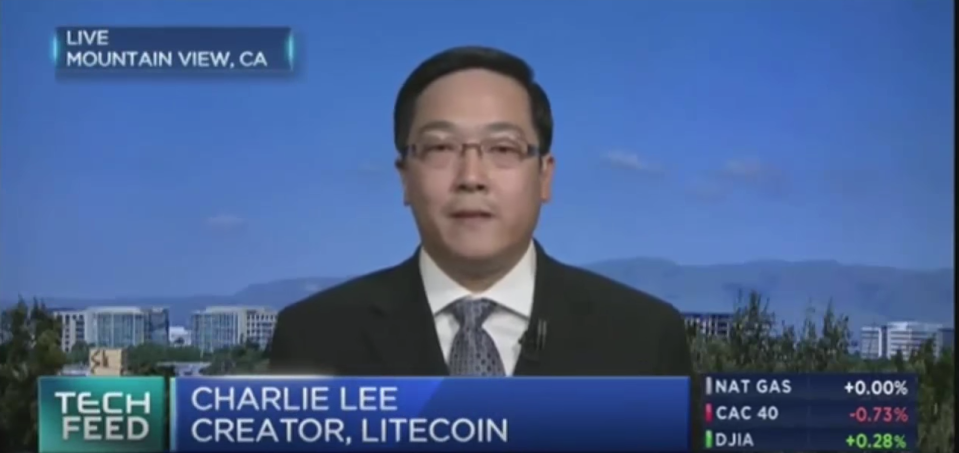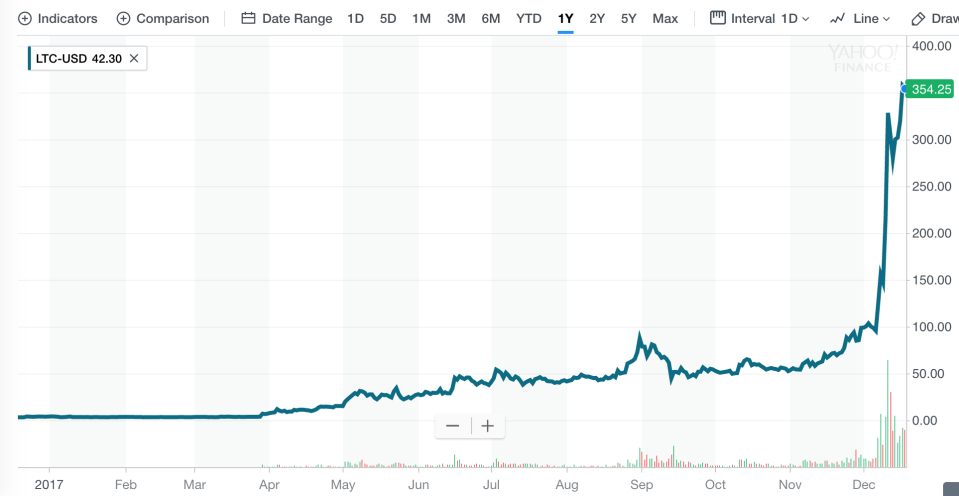What is litecoin?
The value of litecoin was up 8,000% in 2017 as of Dec. 19. It has risen nearly eight times as much as bitcoin has.
So, you may be wondering: What is litecoin? How is it different from bitcoin? How can I buy some? Here are your answers.
What is litecoin, who created it?
Litecoin is an alternative cryptocurrency (people often call these “altcoins”) to bitcoin, created in 2011 by Charlie Lee.
It is the No. 5 cryptocurrency by market cap (see our handy Yahoo Finance crypto screener) and third-oldest cryptocurrency that still exists. Litecoin is also one of the four coins you can currently buy through Coinbase, the most popular mainstream brokerage for buying cryptocurrency, along with bitcoin and ether. So if you’re a crypto newbie looking to buy litecoin, your easiest option is Coinbase. (But we are not dispensing investment advice. Cryptocurrencies are extremely volatile.)
Litecoin is from bitcoin’s source code, and like bitcoin, it operates on a blockchain. Charlie Lee has said in the past he intended litecoin to be the silver to bitcoin’s gold. But there are some key technical differences that have made litecoin appealing recently.
For starters, litecoin’s network is faster than the bitcoin blockchain: mining a “block” of litecoin transactions takes an average 2.5 minutes compared to bitcoin’s 10 minutes. Litecoin transaction fees are also lower: sometimes close to zero. (Bitcoin transaction fees vary based on network activity and can get very high on places like Coinbase.) And Litecoin has a supply cap of 84 million coins, compared to bitcoin’s 21 million.
Litecoin also uses a different proof-of-work algorithm, called Scrypt, than bitcoin, which uses SHA-256. As Coindesk explained in 2014, “The consequences of using scrypt mean that there has not been as much of an ‘arms race’ in litecoin (and other scrypt currencies), because there is (so far) no ASIC technology available for this algorithm.” All that you need to understand about that: mining litecoin was friendlier, and cheaper, than mining bitcoin. But three years later, there are now ASIC machines for mining litecoin.

Unlike bitcoin, created in 2009 by someone (or someones) using the pseudonym Satoshi Nakamoto, the creator of litecoin is very public, and popular on social media.
Lee was an engineer at Google in 2011 when he created litecoin. He joined Coinbase in 2013 as one of the company’s very first hires, and was director of engineering there until he left this year to focus on litecoin full-time.
Using the handle SatoshiLite (get it?) on Twitter, Lee opines on the crypto market, makes jokes, and even issued a word of caution about his coin: “Sorry to spoil the party,” he tweeted, “but I need to reign in the excitement a bit… Buying LTC is extremely risky. I expect us to have a multi-year bear market like the one we just had where LTC dropped 90% in value ($48 to $4). So if you can’t handle LTC dropping to $20, don’t buy!”
Ok, sorry to spoil the party, but I need to reign in the excitement a bit…
Buying LTC is extremely risky. I expect us to have a multi-year bear market like the one we just had where LTC dropped 90% in value ($48 to $4). So if you can't handle LTC dropping to $20, don't buy!
— Charlie Lee [LTC] (@SatoshiLite) December 11, 2017
And on Dec. 19, Lee announced that he has sold off all his litecoin to avoid any accusations of pumping the coin for his own financial gain. “Whenever I tweet about Litecoin price or even just good or bad news, I get accused of doing it for personal benefit,” he wrote. “Some people even think I short LTC! So in a sense, it is conflict of interest for me to hold LTC and tweet about it because I have so much influence… For this reason, in the past days, I have sold and donated all my LTC.”
Why has litecoin risen so much this year?

Like all the different coins, there are a number of possible explanations. It could be crypto insiders seeing the appeal of litecoin’s faster, cheaper network for payments. Or the bump could be thanks to litecoin successfully implementing Segregated Witness (SegWit) this year, a change to the software that, without getting too technical, allows more transaction records to be included in each block of transactions, thereby speeding up the network.
Or it could be investors who fear they missed out on bitcoin’s biggest gains, so they’re flocking to what they see as the potential next best thing. But it’s worth noting Lee’s own warning about the price hike.
Although bitcoin’s market cap is $300 billion to litecoin’s $20 billion, The Motley Fool writes that bitcoin’s biggest competition is litecoin. That’s contrarian to the popular thinking that ethereum will be bitcoin’s biggest challenger.
—
Daniel Roberts covers bitcoin and blockchain at Yahoo Finance. Follow him on Twitter at @readDanwrite.
Read more:
Bought bitcoin? You must practice ‘cold storage’
What exactly is the blockchain?
